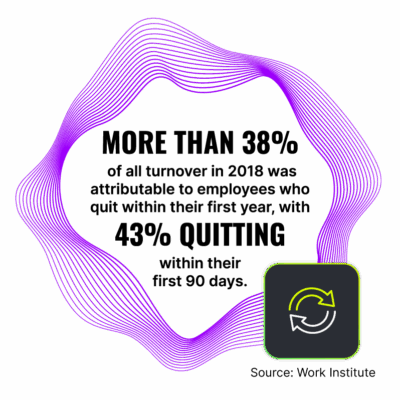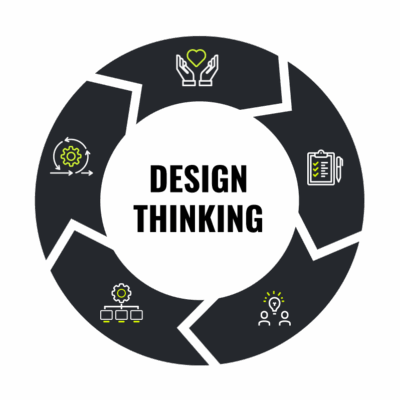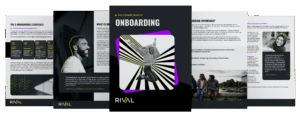How to Apply Design Thinking to Onboarding
Many organizations have compliance-oriented onboarding programs that are focused on completing administrative tasks, and last anywhere from one day to three months on average. These programs generally lack engagement, alignment, and interpersonal connection-building opportunities. The absence of these components opens organizations up to risks in terms of new hire attrition, impacting sourcing costs and productivity.
In this post, we’ll explore applying design thinking to onboarding as a means to drive retention and engagement.
TL;DR
- Most onboarding programs focus on admin tasks, not the new hire experience. Design thinking puts connection at the center of your process.
- Follow the steps Emphasize, Define, Ideate, Prototype, and Test to uncover friction and design meaningful moments.
- Use Rival Workflow to implement personalized onboarding journeys at scale.
The importance of a well-structured onboarding process
According to the 2025 Retention Report by the Work Institute, “Early attrition comprises roughly 40% of all turnover and underscores the need for robust onboarding, tailored support, and early-stage engagement strategies to maximize new hire potential.” The first 90 days of an employee’s tenure with an organization is crucial to their success and longevity.
The 2025 Businessolver® State of Workplace Empathy Report found employees who view their organization as unempathetic are 1.5x more likely to change jobs in the next six months, equating to $180 billion in attrition costs. To achieve empathy, organizations must place employees at the center of all experiences. They must understand what employees are experiencing during moments that matter and provide adequate communication, resources, feedback, and alignment to employees at the right time.

What is design thinking?
“Design thinking is a human-centered, non-linear, and iterative process for creative problem-solving that focuses on understanding user needs to develop innovative solutions” (Interaction Design Foundation). First developed by The Hasso Plattner Institute of Design at Stanford University, the process is broken into five stages:
- Empathize – Observe the actions and experiences new hires are taking
- Define – Identify what specific problem(s) you’re trying to solve and what to focus on as your seeking to formulate a solution
- Ideate – Storming or flaring phase where you think as big as possible to come up with solutions, becoming more fluent with the opportunities that you’re addressing
- Prototype – Enhance empathy for the new hire experience by exploring and creating options and solutions
- Test – Compile learnings across options to refine and continue to iterate to deliver the best experience(s) possible

Applying design thinking to onboarding
📝 Empathize
Start by understanding what new hires think, feel, see, and do during onboarding. Talk to recent hires, managers, IT, and HR partners to uncover friction points and emotional highs and lows. Empathy maps and journey maps can help visualize the moments that matter.
Example: You learn through interviews that new hires feel anxious after accepting the offer and before their first day because they are confused about required paperwork, equipment readiness, or who to contact.
What to do:
- Map moments that matter such as offer acceptance, preboarding, day one, etc.
- Identify the highs (welcome lunch) and lows (no laptop on day one)
❓ Define
Now that you’ve identified the challenges, reframe them into actionable problem statements. Use “How Might We” questions to inspire solutions.
Sample challenges turned into questions:
- How might we ensure every new hire starts day one with equipment ready to go?
- How might we make virtual onboarding feel as personal as in-person onboarding?
- How might we help managers deliver consistent feedback in the first 90 days?
Answers to these questions will focus your team on solving the problems with the biggest emotional and operational impact.
💡 Ideate
Bring together a cross-functional group of HR, IT, facilities, L&D, and hiring managers to get all ideas on the table. This stage is not about editing. It’s about brainstorming.
Sample ideas:
- Create a preboarding portal so new hires can see progress on equipment, logins, and paperwork.
- Deliver personalized learning paths based on role, department, or location.
- Set up automatic manager nudges with 1:1 prompts at key new hire milestones.
📗 Prototype
Choose an idea that you can test and validate quickly with minimal investment.
Sample prototypes:
- Onboarding checklist for new employees – A shared preboarding tracker that automatically alerts IT and facilities when an offer is accepted
- Learning hub – A webpage with links to new hire resources and learning modules
- Check-in workflow – Automated 30/60/90-day reminders to managers with suggested agenda topics and feedback forms
🧪 Test
Choose a subset of new hires to run your test and gather qualitative feedback (how new hires feel about the experience) and quantitative metrics (time-to-productivity and engagement scores).
Example:
You might find that after piloting the preboarding tracker, 95% of new hires have equipment ready on day one, versus only 75% without the tracker.
Once you’re satisfied with the quality of your test, you can integrate the new process into your onboarding workflow and scale it across the organization.
Create a More Mature, Empathetic Onboarding Program with Design Thinking
Adopting a design thinking approach will transform your onboarding from a task-based process to a human-centered experience. Pair that mindset with automation and you can deliver these thoughtful moments at scale.
Here’s how you can use Rival to turn design thinking into action:
- Automate HR processes and critical moments like equipment provisioning, welcome messages, and manager check-ins
- Personalize onboarding journeys by role, location, or contract type so every new hire feels seen and supported
- Orchestrate cross-functional tasks across HR, IT, facilities, and hiring managers, so nothing falls through the cracks
Crafting a thoughtful welcome can be a massive administrative burden, especially as you scale hiring. Let Rival take the operational load off your plate with HR workflow automation.
Schedule your demo to see how Rival’s HR workflow software can automate every moment of your onboarding journey.



















